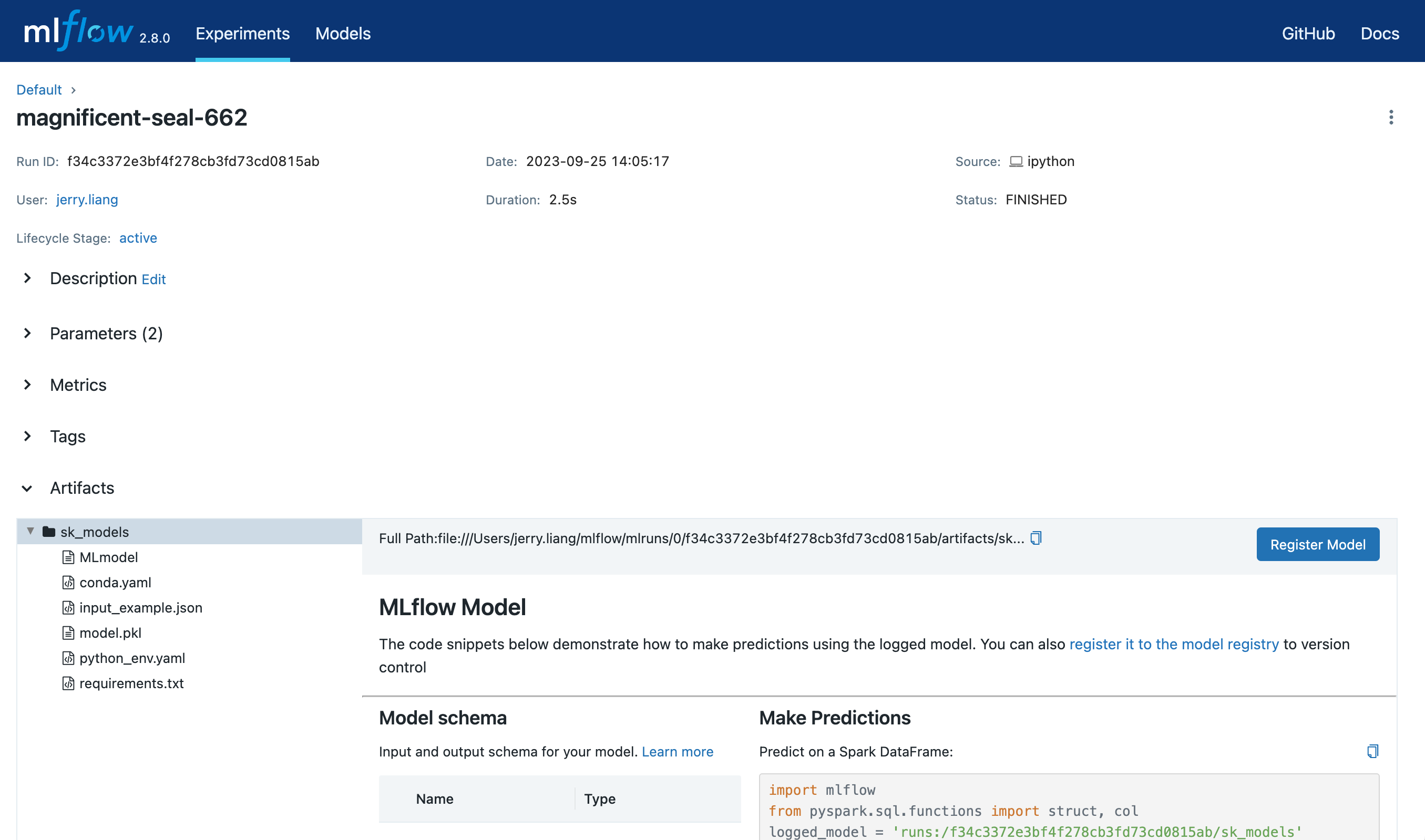MLflow Model Registry
The MLflow Model Registry component is a centralized model store, set of APIs, and UI, to collaboratively manage the full lifecycle of an MLflow Model. It provides model lineage (which MLflow experiment and run produced the model), model versioning, model aliasing, model tagging, and annotations.
Table of Contents
Concepts
The Model Registry introduces a few concepts that describe and facilitate the full lifecycle of an MLflow Model.
- Model
An MLflow Model is created from an experiment or run that is logged with one of the model flavor’s
mlflow.<model_flavor>.log_model()methods. Once logged, this model can then be registered with the Model Registry.- Registered Model
An MLflow Model can be registered with the Model Registry. A registered model has a unique name, contains versions, aliases, tags, and other metadata.
- Model Version
Each registered model can have one or many versions. When a new model is added to the Model Registry, it is added as version 1. Each new model registered to the same model name increments the version number. Model versions have tags, which can be useful for tracking attributes of the model version (e.g. pre_deploy_checks: “PASSED”)
- Model Alias
Model aliases allow you to assign a mutable, named reference to a particular version of a registered model. By assigning an alias to a specific model version, you can use the alias to refer that model version via a model URI or the model registry API. For example, you can create an alias named
championthat points to version 1 of a model namedMyModel. You can then refer to version 1 ofMyModelby using the URImodels:/MyModel@champion.Aliases are especially useful for deploying models. For example, you could assign a
championalias to the model version intended for production traffic and target this alias in production workloads. You can then update the model serving production traffic by reassigning thechampionalias to a different model version.- Tags
Tags are key-value pairs that you associate with registered models and model versions, allowing you to label and categorize them by function or status. For example, you could apply a tag with key
"task"and value"question-answering"(displayed in the UI astask:question-answering) to registered models intended for question answering tasks. At the model version level, you could tag versions undergoing pre-deployment validation withvalidation_status:pendingand those cleared for deployment withvalidation_status:approved.- Annotations and Descriptions
You can annotate the top-level model and each version individually using Markdown, including description and any relevant information useful for the team such as algorithm descriptions, dataset employed or methodology.
Model Registry Workflows
If running your own MLflow server, you must use a database-backed backend store in order to access the model registry via the UI or API. See here for more information.
Before you can add a model to the Model Registry, you must log it using the log_model methods
of the corresponding model flavors. Once a model has been logged, you can add, modify, update,
or delete the model in the Model Registry through the UI or the API.
UI Workflow
This section demonstrates how to use the MLflow Model Registry UI to manage your MLflow models.
Register a Model
Follow the steps below to register your MLflow model in the Model Registry.
Open the details page for the MLflow Run containing the logged MLflow model you’d like to register. Select the model folder containing the intended MLflow model in the Artifacts section.
Click the Register Model button, which will trigger a form to pop up.
In the Model dropdown menu on the form, you can either select “Create New Model”, which creates a new registered model with your MLflow model as its initial version, or select an existing registered model, which registers your model under it as a new version. The screenshot below demonstrates registering the MLflow model to a new registered model named
"iris_model_testing".
Find Registered Models
After you’ve registered your models in the Model Registry, you can navigate to them in the following ways.
Navigate to the Registered Models page, which links to your registered models and correponding model versions.

Go to the Artifacts section of your MLflow Runs details page, click the model folder, and then click the model version at the top right to view the version created from that model.

Deploy and Organize Models
You can deploy and organize your models in the Model Registry using model aliases and tags. To set aliases and tags for model versions in your registered model, navigate to the overview page of your registered model, such as the one below.
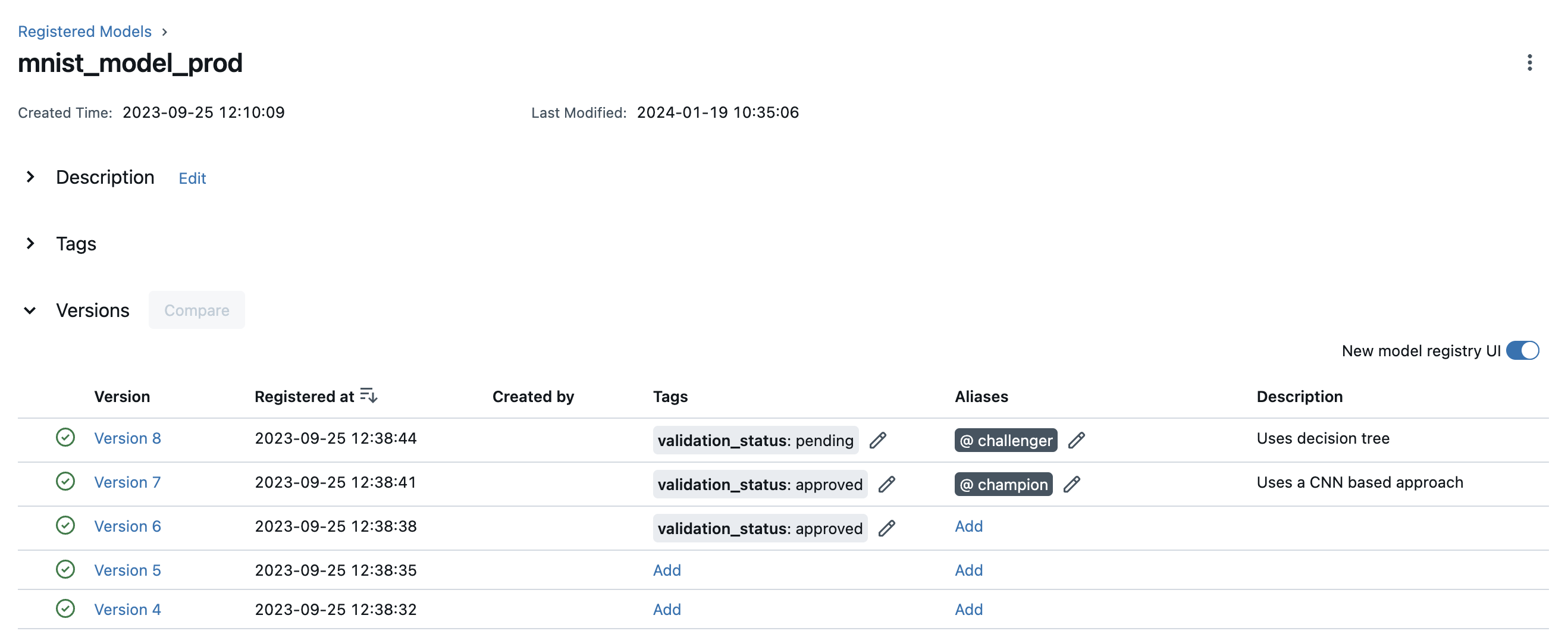
You can add or edit aliases and tags for a specific model version by clicking on the corresponding Add link or pencil icon in the model verison table.
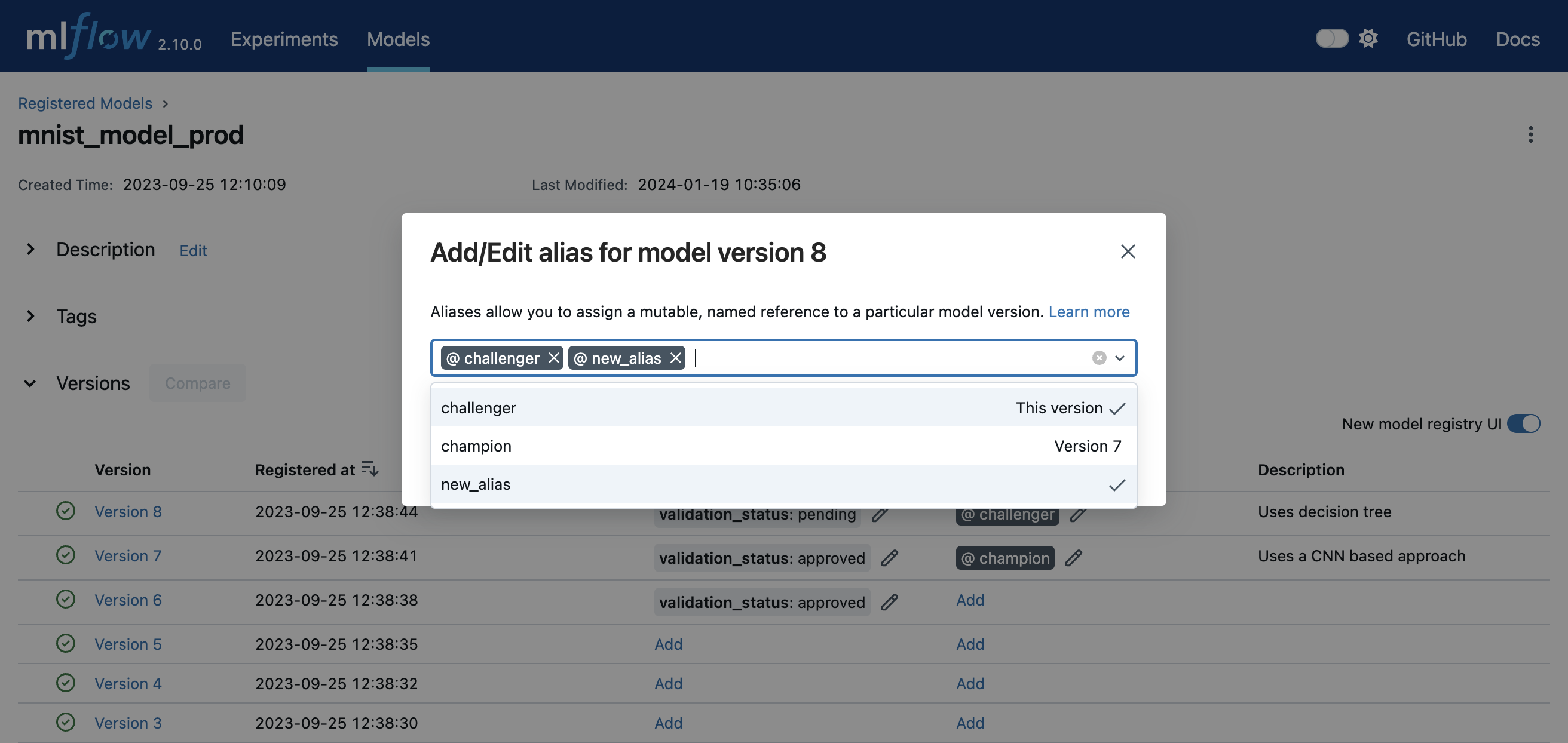
To learn more about a specific model version, navigate to the details page for that model version.
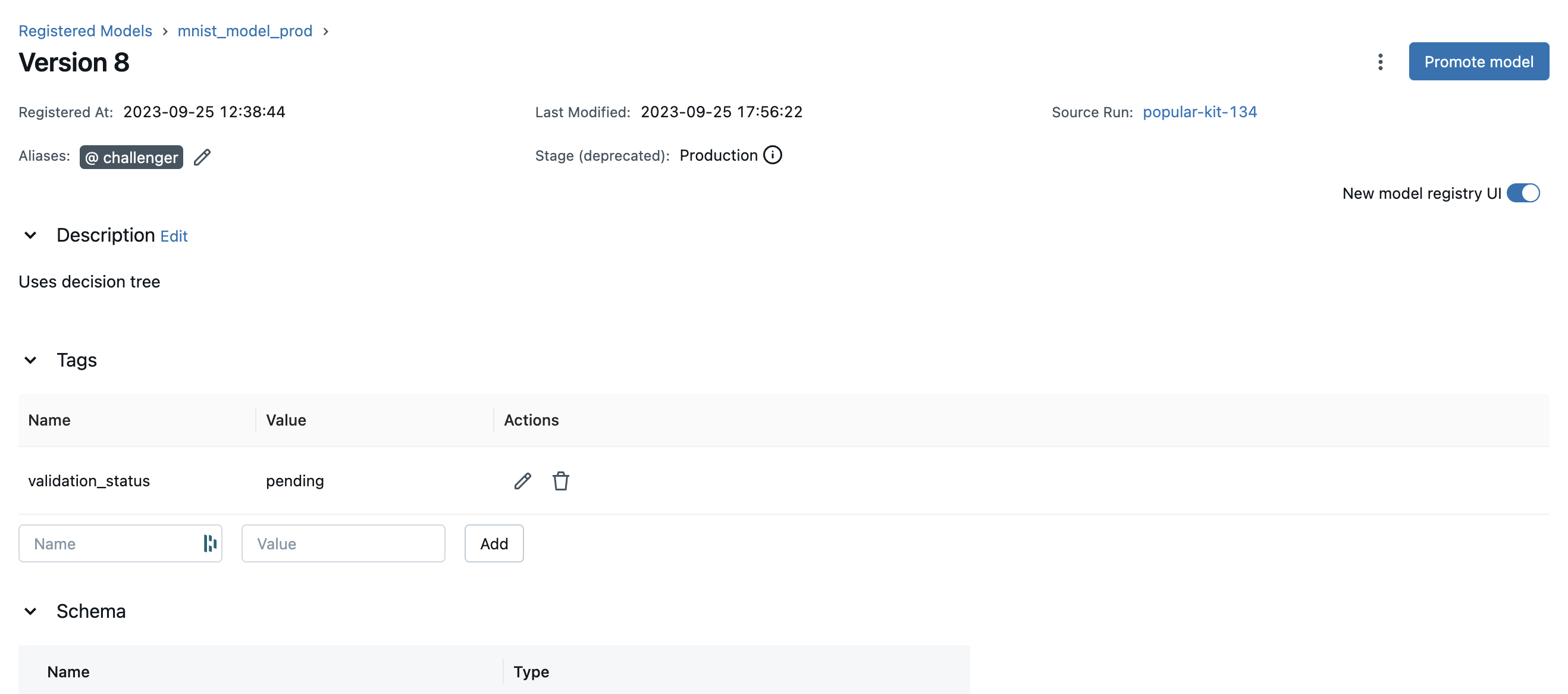
In this page, you can inspect model version details like the model signature, MLflow source run, and creation timestamp. You can also view and configure the verion’s aliases, tags, and description.
API Workflow
An alternative way to interact with Model Registry is using the MLflow model flavor or MLflow Client Tracking API interface. In particular, you can register a model during an MLflow experiment run or after all your experiment runs.
Adding an MLflow Model to the Model Registry
There are three programmatic ways to add a model to the registry. First, you can use the mlflow.<model_flavor>.log_model() method. For example, in your code:
from sklearn.datasets import make_regression
from sklearn.ensemble import RandomForestRegressor
from sklearn.metrics import mean_squared_error
from sklearn.model_selection import train_test_split
import mlflow
import mlflow.sklearn
from mlflow.models import infer_signature
with mlflow.start_run() as run:
X, y = make_regression(n_features=4, n_informative=2, random_state=0, shuffle=False)
X_train, X_test, y_train, y_test = train_test_split(
X, y, test_size=0.2, random_state=42
)
params = {"max_depth": 2, "random_state": 42}
model = RandomForestRegressor(**params)
model.fit(X_train, y_train)
# Infer the model signature
y_pred = model.predict(X_test)
signature = infer_signature(X_test, y_pred)
# Log parameters and metrics using the MLflow APIs
mlflow.log_params(params)
mlflow.log_metrics({"mse": mean_squared_error(y_test, y_pred)})
# Log the sklearn model and register as version 1
mlflow.sklearn.log_model(
sk_model=model,
artifact_path="sklearn-model",
signature=signature,
registered_model_name="sk-learn-random-forest-reg-model",
)
In the above code snippet, if a registered model with the name doesn’t exist, the method registers a new model and creates Version 1. If a registered model with the name exists, the method creates a new model version.
The second way is to use the mlflow.register_model() method, after all your experiment runs complete and when you have decided which model is most suitable to add to the registry.
For this method, you will need the run_id as part of the runs:URI argument.
result = mlflow.register_model(
"runs:/d16076a3ec534311817565e6527539c0/sklearn-model", "sk-learn-random-forest-reg"
)
If a registered model with the name doesn’t exist, the method registers a new model, creates Version 1, and returns a ModelVersion MLflow object. If a registered model with the name exists, the method creates a new model version and returns the version object.
And finally, you can use the create_registered_model() to create a new registered model. If the model name exists,
this method will throw an MlflowException because creating a new registered model requires a unique name.
from mlflow import MlflowClient
client = MlflowClient()
client.create_registered_model("sk-learn-random-forest-reg-model")
The method above creates an empty registered model with no version associated. You can use create_model_version()
as shown below to create a new version of the model.
client = MlflowClient()
result = client.create_model_version(
name="sk-learn-random-forest-reg-model",
source="mlruns/0/d16076a3ec534311817565e6527539c0/artifacts/sklearn-model",
run_id="d16076a3ec534311817565e6527539c0",
)
Databricks Unity Catalog Model Registry
To use Databricks unity catalog model registry, set MLflow registry URI to "databricks-uc", and set the two environmental variables "DATABRICKS_HOST" and "DATABRICKS_TOKEN". If you are using Databricks OAuth authentication, set the three environmental variables "DATABRICKS_HOST", "DATABRICKS_CLIENT_ID" and "DATABRICKS_CLIENT_SECRET". If you have configured your access auth within the '~/.databrickscfg' file, then you don’t need to set above environmental variables. Instead, you can set the MLflow registry URI to "databricks-uc://{profile}", the '{profile}' part being the profile name in your '~/.databrickscfg' configuration file. For details of Databricks authentication types, please refer to this document <https://docs.databricks.com/en/dev-tools/auth/index.html#unified-auth>.
Use Databricks unity catalog model registry by Databricks shard token
import mlflow
import os
mlflow.set_registry_uri("databricks-uc")
os.environ["DATABRICKS_HOST"] = "<your Databricks shard URI>"
os.environ["DATABRICKS_TOKEN"] = "<your Databricks shard access token>"
Use Databricks unity catalog model registry by Databricks OAuth authentication
import mlflow
import os
mlflow.set_registry_uri("databricks-uc")
os.environ["DATABRICKS_HOST"] = "<your Databricks shard URI>"
os.environ["DATABRICKS_CLIENT_ID"] = "<your Databricks oauth client ID>"
os.environ["DATABRICKS_CLIENT_SECRET"] = "<your Databricks oauth client secret>"
Use Databricks unity catalog model registry with ‘~/.databrickscfg’ configuration file
Assuming you have configured local ‘~/.databrickscfg’ file with a section like:
[my-databricks-shard1] host = <your Databricks shard URI> token = <your Databricks shard access token>
import mlflow
import os
mlflow.set_registry_uri("databricks-uc://my-databricks-shard1")
OSS Unity Catalog Model Registry
To use an OSS Unity Catalog server as your MLflow model registry, specify the UC server address in the MLflow registry URI in the format "uc:http://localhost:8080". If your unity catalog server is configured to use authentication, set the environmental variable "MLFLOW_UC_OSS_TOKEN".
Use the OSS unity catalog model registry using a bearer token
import mlflow
import os
mlflow.set_registry_uri("uc:http://localhost:8080")
# Set this environment variable for MLflow to use your UC OSS token
os.environ["MLFLOW_UC_OSS_TOKEN"] = "<your OSS UC access token>"
Deploy and Organize Models with Aliases and Tags
Model aliases and tags help you deploy and organize your models in the Model Registry.
Set and delete aliases on models
To set, update, and delete aliases using the MLflow Client API, see the examples below:
from mlflow import MlflowClient
client = MlflowClient()
# create "champion" alias for version 1 of model "example-model"
client.set_registered_model_alias("example-model", "champion", 1)
# reassign the "Champion" alias to version 2
client.set_registered_model_alias("example-model", "Champion", 2)
# get a model version by alias
client.get_model_version_by_alias("example-model", "Champion")
# delete the alias
client.delete_registered_model_alias("example-model", "Champion")
Set and delete tags on models
To set and delete tags using the MLflow Client API, see the examples below:
from mlflow import MlflowClient
client = MlflowClient()
# Set registered model tag
client.set_registered_model_tag("example-model", "task", "classification")
# Delete registered model tag
client.delete_registered_model_tag("example-model", "task")
# Set model version tag
client.set_model_version_tag("example-model", "1", "validation_status", "approved")
# Delete model version tag
client.delete_model_version_tag("example-model", "1", "validation_status")
For more details on alias and tag client APIs, see the mlflow.client API documentation.
Fetching an MLflow Model from the Model Registry
After you have registered an MLflow model, you can fetch that model using mlflow.<model_flavor>.load_model(), or more generally, load_model().
You can use the loaded model for one off predictions or in inference workloads such as batch inference.
Fetch a specific model version
To fetch a specific model version, just supply that version number as part of the model URI.
import mlflow.pyfunc
model_name = "sk-learn-random-forest-reg-model"
model_version = 1
model = mlflow.pyfunc.load_model(model_uri=f"models:/{model_name}/{model_version}")
model.predict(data)
Fetch a model version by alias
To fetch a model version by alias, specify the model alias in the model URI, and it will fetch the model version currently under it.
import mlflow.pyfunc
model_name = "sk-learn-random-forest-reg-model"
alias = "champion"
champion_version = mlflow.pyfunc.load_model(f"models:/{model_name}@{alias}")
champion_version.predict(data)
Note that model alias assignments can be updated independently of your production code. If the champion alias in the snippet above is reassigned to a new model version in the Model Registry, the next execution of this snippet will automatically pick up the new model version. This allows you to decouple model deployments from your inference workloads.
Serving an MLflow Model from Model Registry
After you have registered an MLflow model, you can serve the model as a service on your host.
#!/usr/bin/env sh
# Set environment variable for the tracking URL where the Model Registry resides
export MLFLOW_TRACKING_URI=http://localhost:5000
# Serve the production model from the model registry
mlflow models serve -m "models:/sk-learn-random-forest-reg-model@champion"
Promoting an MLflow Model across environments
In mature DevOps and MLOps workflows, organizations use separate environments (typically, dev,
staging, and prod) with access controls to enable quick development without compromising stability
in production. In MLflow, you can use registered models and MLflow Authentication to
express access-controlled environments for your MLflow models. For example, you can create registered
models corresponding to each combination of environment and business problem (e.g.
prod.ml_team.revenue_forecasting, dev.ml_team.revenue_forecasting) and configure permissions
accordingly. As you iterate on MLflow models for your business problem, you can promote them
through the various environments for continuous integration and deployment.
For mature production-grade setups, we recommend setting up automated workflows that train and register models in each environment. To productionize the latest iteration on a business problem, promote your machine learning code across environments via source control and CI/CD systems.
For simple model deployment use cases, you can register your trained MLflow Model to a dev environment
registered model as the latest model version and then use copy_model_version()
to promote it across registered models.
from mlflow import MlflowClient
client = MlflowClient()
client.copy_model_version(
src_model_uri="models:/regression-model-staging@candidate",
dst_name="regression-model-production",
)
This code snippet copies the model version with the candidate alias in the regression-model-staging
model to the regression-model-production model as the latest version.
You can also promote model versions in the UI. To do this, navigate to the model version details page
and select the Promote model button. This opens a modal where you can choose a registered model
to which the current model version will be copied.
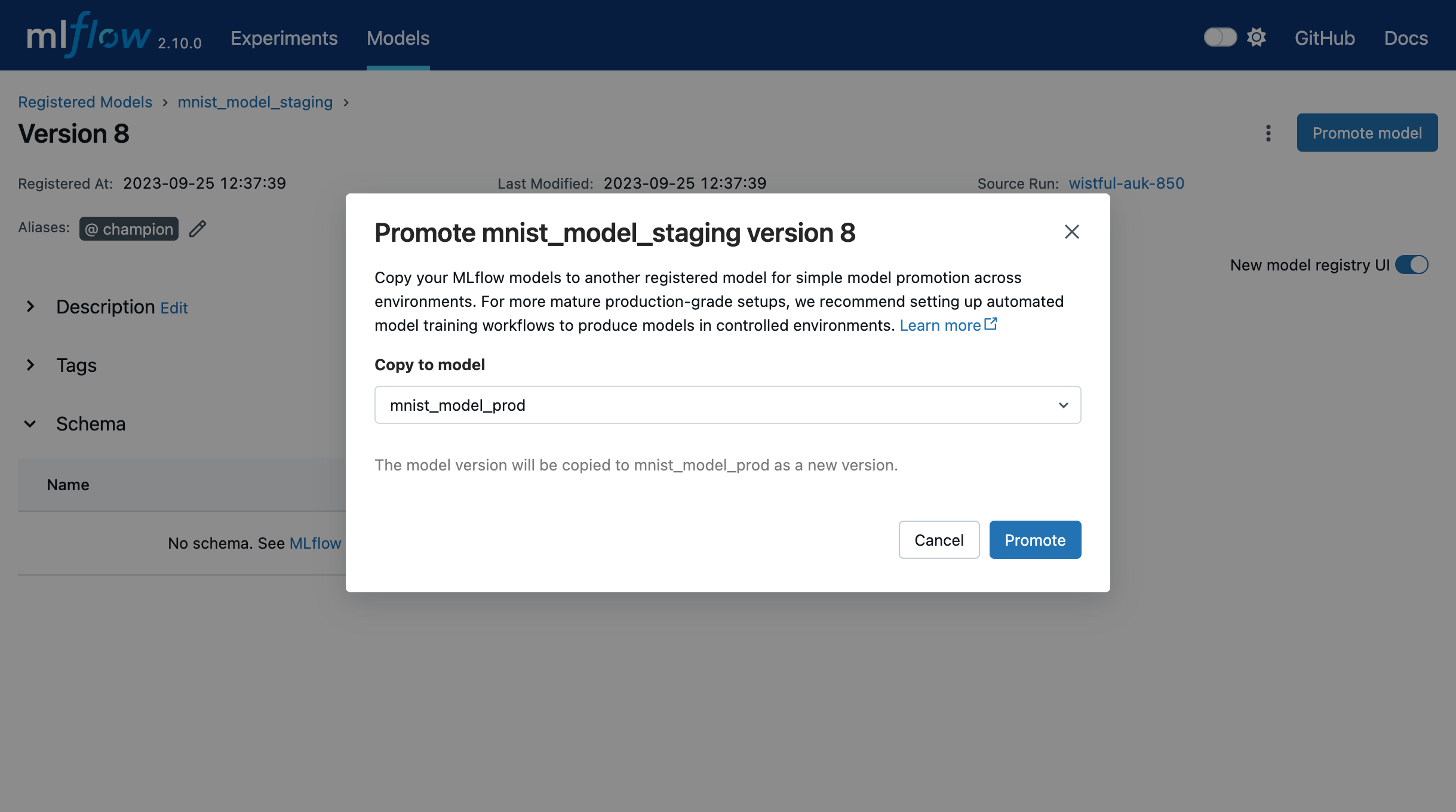
Adding or Updating an MLflow Model Descriptions
At any point in a model’s lifecycle development, you can update a model version’s description using update_model_version().
client = MlflowClient()
client.update_model_version(
name="sk-learn-random-forest-reg-model",
version=1,
description="This model version is a scikit-learn random forest containing 100 decision trees",
)
Renaming an MLflow Model
As well as adding or updating a description of a specific version of the model, you can rename an existing registered model using rename_registered_model().
client = MlflowClient()
client.rename_registered_model(
name="sk-learn-random-forest-reg-model",
new_name="sk-learn-random-forest-reg-model-100",
)
Listing and Searching MLflow Models
You can fetch a list of registered models in the registry with a simple method.
from pprint import pprint
client = MlflowClient()
for rm in client.search_registered_models():
pprint(dict(rm), indent=4)
This outputs:
{ 'creation_timestamp': 1582671933216,
'description': None,
'last_updated_timestamp': 1582671960712,
'latest_versions': [<ModelVersion: creation_timestamp=1582671933246, current_stage='Production', description='A random forest model containing 100 decision trees trained in scikit-learn', last_updated_timestamp=1582671960712, name='sk-learn-random-forest-reg-model', run_id='ae2cc01346de45f79a44a320aab1797b', source='./mlruns/0/ae2cc01346de45f79a44a320aab1797b/artifacts/sklearn-model', status='READY', status_message=None, user_id=None, version=1>,
<ModelVersion: creation_timestamp=1582671960628, current_stage='None', description=None, last_updated_timestamp=1582671960628, name='sk-learn-random-forest-reg-model', run_id='d994f18d09c64c148e62a785052e6723', source='./mlruns/0/d994f18d09c64c148e62a785052e6723/artifacts/sklearn-model', status='READY', status_message=None, user_id=None, version=2>],
'name': 'sk-learn-random-forest-reg-model'}
With hundreds of models, it can be cumbersome to peruse the results returned from this call. A more efficient approach would be to search for a specific model name and list its version
details using search_model_versions() method
and provide a filter string such as "name='sk-learn-random-forest-reg-model'"
client = MlflowClient()
for mv in client.search_model_versions("name='sk-learn-random-forest-reg-model'"):
pprint(dict(mv), indent=4)
This outputs:
{
"creation_timestamp": 1582671933246,
"current_stage": "Production",
"description": "A random forest model containing 100 decision trees "
"trained in scikit-learn",
"last_updated_timestamp": 1582671960712,
"name": "sk-learn-random-forest-reg-model",
"run_id": "ae2cc01346de45f79a44a320aab1797b",
"source": "./mlruns/0/ae2cc01346de45f79a44a320aab1797b/artifacts/sklearn-model",
"status": "READY",
"status_message": None,
"user_id": None,
"version": 1,
}
{
"creation_timestamp": 1582671960628,
"current_stage": "None",
"description": None,
"last_updated_timestamp": 1582671960628,
"name": "sk-learn-random-forest-reg-model",
"run_id": "d994f18d09c64c148e62a785052e6723",
"source": "./mlruns/0/d994f18d09c64c148e62a785052e6723/artifacts/sklearn-model",
"status": "READY",
"status_message": None,
"user_id": None,
"version": 2,
}
Deleting MLflow Models
Note
Deleting registered models or model versions is irrevocable, so use it judiciously.
You can either delete specific versions of a registered model or you can delete a registered model and all its versions.
# Delete versions 1,2, and 3 of the model
client = MlflowClient()
versions = [1, 2, 3]
for version in versions:
client.delete_model_version(
name="sk-learn-random-forest-reg-model", version=version
)
# Delete a registered model along with all its versions
client.delete_registered_model(name="sk-learn-random-forest-reg-model")
While the above workflow API demonstrates interactions with the Model Registry, two exceptional cases require attention. One is when you have existing ML models saved from training without the use of MLflow. Serialized and persisted on disk in sklearn’s pickled format, you want to register this model with the Model Registry. The second is when you use an ML framework without a built-in MLflow model flavor support, for instance, vaderSentiment, and want to register the model.
Registering a Model Saved Outside MLflow
Not everyone will start their model training with MLflow. So you may have some models trained before the use of MLflow. Instead of retraining the models, all you want to do is register your saved models with the Model Registry.
This code snippet creates a sklearn model, which we assume that you had created and saved in native pickle format.
Note
The sklearn library and pickle versions with which the model was saved should be compatible with the current MLflow supported built-in sklearn model flavor.
import numpy as np
import pickle
from sklearn import datasets, linear_model
from sklearn.metrics import mean_squared_error, r2_score
# source: https://scikit-learn.org/stable/auto_examples/linear_model/plot_ols.html
# Load the diabetes dataset
diabetes_X, diabetes_y = datasets.load_diabetes(return_X_y=True)
# Use only one feature
diabetes_X = diabetes_X[:, np.newaxis, 2]
# Split the data into training/testing sets
diabetes_X_train = diabetes_X[:-20]
diabetes_X_test = diabetes_X[-20:]
# Split the targets into training/testing sets
diabetes_y_train = diabetes_y[:-20]
diabetes_y_test = diabetes_y[-20:]
def print_predictions(m, y_pred):
# The coefficients
print("Coefficients: \n", m.coef_)
# The mean squared error
print("Mean squared error: %.2f" % mean_squared_error(diabetes_y_test, y_pred))
# The coefficient of determination: 1 is perfect prediction
print("Coefficient of determination: %.2f" % r2_score(diabetes_y_test, y_pred))
# Create linear regression object
lr_model = linear_model.LinearRegression()
# Train the model using the training sets
lr_model.fit(diabetes_X_train, diabetes_y_train)
# Make predictions using the testing set
diabetes_y_pred = lr_model.predict(diabetes_X_test)
print_predictions(lr_model, diabetes_y_pred)
# save the model in the native sklearn format
filename = "lr_model.pkl"
pickle.dump(lr_model, open(filename, "wb"))
Coefficients:
[938.23786125]
Mean squared error: 2548.07
Coefficient of determination: 0.47
Once saved in pickled format, you can load the sklearn model into memory using pickle API and register the loaded model with the Model Registry.
import mlflow
from mlflow.models import infer_signature
import numpy as np
from sklearn import datasets
# load the model into memory
loaded_model = pickle.load(open(filename, "rb"))
# create a signature for the model based on the input and output data
diabetes_X, diabetes_y = datasets.load_diabetes(return_X_y=True)
diabetes_X = diabetes_X[:, np.newaxis, 2]
signature = infer_signature(diabetes_X, diabetes_y)
# log and register the model using MLflow scikit-learn API
mlflow.set_tracking_uri("sqlite:///mlruns.db")
reg_model_name = "SklearnLinearRegression"
print("--")
mlflow.sklearn.log_model(
loaded_model,
"sk_learn",
serialization_format="cloudpickle",
signature=signature,
registered_model_name=reg_model_name,
)
--
Successfully registered model 'SklearnLinearRegression'.
2021/04/02 16:30:57 INFO mlflow.tracking._model_registry.client: Waiting up to 300 seconds for model version to finish creation.
Model name: SklearnLinearRegression, version 1
Created version '1' of model 'SklearnLinearRegression'.
Now, using MLflow fluent APIs, you reload the model from the Model Registry and score.
# load the model from the Model Registry and score
model_uri = f"models:/{reg_model_name}/1"
loaded_model = mlflow.sklearn.load_model(model_uri)
print("--")
# Make predictions using the testing set
diabetes_y_pred = loaded_model.predict(diabetes_X_test)
print_predictions(loaded_model, diabetes_y_pred)
--
Coefficients:
[938.23786125]
Mean squared error: 2548.07
Coefficient of determination: 0.47
Registering an Unsupported Machine Learning Model
In some cases, you might use a machine learning framework without its built-in MLflow Model flavor support. For instance, the vaderSentiment library is a standard Natural Language Processing (NLP) library used for sentiment analysis. Since it lacks a built-in MLflow Model flavor, you cannot log or register the model using MLflow Model fluent APIs.
To work around this problem, you can create an instance of a mlflow.pyfunc model flavor and embed your NLP model
inside it, allowing you to save, log or register the model. Once registered, load the model from the Model Registry
and score using the predict function.
The code sections below demonstrate how to create a PythonFuncModel class with a vaderSentiment model embedded in it,
save, log, register, and load from the Model Registry and score.
Note
To use this example, you will need to pip install vaderSentiment.
from sys import version_info
import cloudpickle
import pandas as pd
import mlflow.pyfunc
from vaderSentiment.vaderSentiment import SentimentIntensityAnalyzer
#
# Good and readable paper from the authors of this package
# http://comp.social.gatech.edu/papers/icwsm14.vader.hutto.pdf
#
INPUT_TEXTS = [
{"text": "This is a bad movie. You don't want to see it! :-)"},
{"text": "Ricky Gervais is smart, witty, and creative!!!!!! :D"},
{"text": "LOL, this guy fell off a chair while sleeping and snoring in a meeting"},
{"text": "Men shoots himself while trying to steal a dog, OMG"},
{"text": "Yay!! Another good phone interview. I nailed it!!"},
{
"text": "This is INSANE! I can't believe it. How could you do such a horrible thing?"
},
]
PYTHON_VERSION = f"{version_info.major}.{version_info.minor}.{version_info.micro}"
def score_model(model):
# Use inference to predict output from the customized PyFunc model
for i, text in enumerate(INPUT_TEXTS):
text = INPUT_TEXTS[i]["text"]
m_input = pd.DataFrame([text])
scores = loaded_model.predict(m_input)
print(f"<{text}> -- {str(scores[0])}")
# Define a class and extend from PythonModel
class SocialMediaAnalyserModel(mlflow.pyfunc.PythonModel):
def __init__(self):
super().__init__()
# embed your vader model instance
self._analyser = SentimentIntensityAnalyzer()
# preprocess the input with prediction from the vader sentiment model
def _score(self, txt):
prediction_scores = self._analyser.polarity_scores(txt)
return prediction_scores
def predict(self, context, model_input, params=None):
# Apply the preprocess function from the vader model to score
model_output = model_input.apply(lambda col: self._score(col))
return model_output
model_path = "vader"
reg_model_name = "PyFuncVaderSentiments"
vader_model = SocialMediaAnalyserModel()
# Set the tracking URI to use local SQLAlchemy db file and start the run
# Log MLflow entities and save the model
mlflow.set_tracking_uri("sqlite:///mlruns.db")
# Save the conda environment for this model.
conda_env = {
"channels": ["defaults", "conda-forge"],
"dependencies": [f"python={PYTHON_VERSION}", "pip"],
"pip": [
"mlflow",
f"cloudpickle=={cloudpickle.__version__}",
"vaderSentiment==3.3.2",
],
"name": "mlflow-env",
}
# Save the model
with mlflow.start_run(run_name="Vader Sentiment Analysis") as run:
model_path = f"{model_path}-{run.info.run_uuid}"
mlflow.log_param("algorithm", "VADER")
mlflow.log_param("total_sentiments", len(INPUT_TEXTS))
mlflow.pyfunc.save_model(
path=model_path, python_model=vader_model, conda_env=conda_env
)
# Use the saved model path to log and register into the model registry
mlflow.pyfunc.log_model(
artifact_path=model_path,
python_model=vader_model,
registered_model_name=reg_model_name,
conda_env=conda_env,
)
# Load the model from the model registry and score
model_uri = f"models:/{reg_model_name}/1"
loaded_model = mlflow.pyfunc.load_model(model_uri)
score_model(loaded_model)
Successfully registered model 'PyFuncVaderSentiments'.
2021/04/05 10:34:15 INFO mlflow.tracking._model_registry.client: Waiting up to 300 seconds for model version to finish creation.
Created version '1' of model 'PyFuncVaderSentiments'.
<This is a bad movie. You don't want to see it! :-)> -- {'neg': 0.307, 'neu': 0.552, 'pos': 0.141, 'compound': -0.4047}
<Ricky Gervais is smart, witty, and creative!!!!!! :D> -- {'neg': 0.0, 'neu': 0.316, 'pos': 0.684, 'compound': 0.8957}
<LOL, this guy fell off a chair while sleeping and snoring in a meeting> -- {'neg': 0.0, 'neu': 0.786, 'pos': 0.214, 'compound': 0.5473}
<Men shoots himself while trying to steal a dog, OMG> -- {'neg': 0.262, 'neu': 0.738, 'pos': 0.0, 'compound': -0.4939}
<Yay!! Another good phone interview. I nailed it!!> -- {'neg': 0.0, 'neu': 0.446, 'pos': 0.554, 'compound': 0.816}
<This is INSANE! I can't believe it. How could you do such a horrible thing?> -- {'neg': 0.357, 'neu': 0.643, 'pos': 0.0, 'compound': -0.8034}
Deprecated: Using Model Stages
Warning
Model Stages are deprecated and will be removed in a future major release. To learn more about this deprecation, see our migration guide below.
See the sections below on using Model Stages in the MLflow Model Registry.
Transitioning an MLflow Model’s Stage
Over the course of the model’s lifecycle, a model evolves—from development to staging to production. You can transition a registered model to one of the stages: Staging, Production or Archived.
client = MlflowClient()
client.transition_model_version_stage(
name="sk-learn-random-forest-reg-model", version=3, stage="Production"
)
The accepted values for <stage> are: Staging|Archived|Production|None.
Fetch the latest model version in a specific stage
To fetch a model version by stage, simply provide the model stage as part of the model URI, and it will fetch the most recent version of the model in that stage.
import mlflow.pyfunc
model_name = "sk-learn-random-forest-reg-model"
stage = "Staging"
model = mlflow.pyfunc.load_model(model_uri=f"models:/{model_name}/{stage}")
model.predict(data)
Archiving an MLflow Model
You can move models versions out of a Production stage into an Archived stage. At a later point, if that archived model is not needed, you can delete it.
# Archive models version 3 from Production into Archived
client = MlflowClient()
client.transition_model_version_stage(
name="sk-learn-random-forest-reg-model", version=3, stage="Archived"
)
Migrating from Stages
As of MLflow 2.9.0, Model Stages have been deprecated and will be removed in a future major release. This is the culmination of extensive feedback on the inflexibility of model stages for expressing MLOps workflows, from which we developed and introduced of new tools for managing and deploying models in the MLflow Model Registry. Learn more below.
New model deployment tools
Model stages were used to express the lifecycle of MLflow Models for productionization and deployment. Users transitioned model versions through four fixed stages (from none, to staging, to production, and then to archived) as they proposed, validated, deployed, and deprecated models for their ML use-cases. In doing so, model registry stages provided labeling and aliasing functionality for the model versions, by denoting the status of a model version in the UI and providing named references to model versions in the code (e.g. /Staging in the model URI). Model registry stages were also used to denote the environment that the model is in, though it was not possible to set up access controls for them.
To replace and improve upon stages, we elevated model version tags in the UI and introduced model version aliases to provide flexible and powerful ways to label and alias MLflow models in the Model Registry. We also made it possible to set up separate environments for your models and configure access controls for each environment.
Model version tags
Model version tags can be used to annotate model versions with their status. For example, you could apply a tag of key validation_status and value pending to a model version while it is being validated and then update the tag value to passed when it has passed smoke tests and performance tests.
Model version aliases
Model version aliases provide a flexible way to create named references for particular model versions, and are useful for identifying which model version(s) are deployed within an environment. For example, setting a champion alias on a model version enables you to fetch the model version by that alias via the get_model_version_by_alias() client API or the model URI models:/<registered model name>@champion. Aliases can be reassigned to new model versions via the UI and client API. Unlike model registry stages, more than one alias can be applied to any given model version, allowing for easier A/B testing and model rollout.
Set up separate environments for models
In mature DevOps and MLOps workflows, organizations use separate environments (typically, dev, staging, and prod) with access controls to enable quick development without compromising stability in production. With MLflow Authentication, you can use registered models to express access-controlled environments for your MLflow models. For example, you can create registered models corresponding to each combination of environment and business problem (e.g. prod.ml_team.revenue_forecasting, dev.ml_team.revenue_forecasting) and configure permissions accordingly. Automate model retraining against your production registered models, or for simple model deployment use cases, use copy_model_version() to promote model versions across registered models.
Migrating models away from stages
See the information below to learn how to use the new tools for your legacy Model Stage use-cases.
Model environments
To set up separate environments and permissions for your model versions, create separate registered models:
Given a base name for your model’s use-case, e.g.
revenue_forecasting, set up various registered models corresponding to your environments with different prefixes.For example, if you want three separate dev, staging, and production environments, you can set up
dev.ml_team.revenue_forecasting,staging.ml_team.revenue_forecasting, andprod.ml_team.revenue_forecastingregistered models.Use MLflow Authentication to grant appropriate permissions on these models.
Transition models across environments
Once you have registered models set up for each environment, you can build your MLOps workflows on top of them.
For simple model promotion use cases, you can first register your MLflow models under the dev registered model and then promote models across environments using the
copy_model_version()client API.For more mature production-grade setups, we recommend promoting your ML code (including model training code, inference code, and ML infrastructure as code) across environments. This eliminates the need to transition models across environments. Dev ML code is experimental and in a dev environment, hence targeting the dev registered model. Before merging developed ML code into your source code repository, your CI stages the code in a staging environment for integration testing (targeting the staging registered model). Post-merge, the ML code is deployed to production for automated retraining (targeting the prod registered model). Such setups enable safe and robust CI/CD of ML systems - including not just model training, but also feature engineering, model monitoring, and automated retraining.
Model aliasing
To specify (via named references) which model version to deploy to serve traffic within an environment (e.g. production), use model aliases:
Decide on an equivalent model alias for each model registry stage (e.g., champion for the Production stage, to specify the model intended to serve the majority of traffic)
Assign the chosen alias to the latest model version under each stage. You can use the helper function below for this.
Update ML workflows to target the alias rather than the stage. For example, the model URI
models:/regression_model/Productionwill be replaced by the model URImodels:/prod.ml_team.regression_model@championin the production code.
from mlflow import MlflowClient
# Initialize an MLflow Client
client = MlflowClient()
def assign_alias_to_stage(model_name, stage, alias):
"""
Assign an alias to the latest version of a registered model within a specified stage.
:param model_name: The name of the registered model.
:param stage: The stage of the model version for which the alias is to be assigned. Can be
"Production", "Staging", "Archived", or "None".
:param alias: The alias to assign to the model version.
:return: None
"""
latest_mv = client.get_latest_versions(model_name, stages=[stage])[0]
client.set_registered_model_alias(model_name, alias, latest_mv.version)
Model status
To represent and communicate the status of your model versions, use model version tags:
Set tags on model versions to indicate the status of the model.
For example, to indicate the review status of a model version, you can set a tag with key
validation_statusand valuependingorpassed.
